Find more information in the General Comments section of the assessment
Find more information in the Rating Validity tab of the assessment
- See More
- See More
- See More
- See More
- Good
- Adequate
- Marginal
- Weak
- Poor
 Passenger
Passenger
 Driver
Driver
 Rear Passenger
Rear Passenger
 Driver
Driver
 Car
Car
 Pole
Pole
 Rear Seat
Rear Seat
 Front Seat
Front Seat
- Good
- Adequate
- Marginal
- Weak
- Poor


Passenger
outboard
center
Fitted to the vehicle as standard
Not fitted to the test vehicle but available as option
Not Available
-
Infants up to 13 kg
-
Infants and toddlers up to 18 kg
-
Toddlers from 9 to 18 kg
-
Toddlers over 18 kg
Easy
Difficult
Safety critical
Not allowed
| Seat Position | ||||
|---|---|---|---|---|
| Front | 2nd row | |||
| Passenger | Left | center | Right | |
| Maxi Cosi Cabriofix (Belt) | ||||
| Britax Römer King Plus (Belt) | ||||
| Britax Römer Duo Plus (ISOFIX) | ||||
| Britax Römer KidFix (Belt) | ||||
| Maxi Cosi Cabriofix & EasyFix (Belt) | ||||
| Maxi Cosi Cabriofix & EasyFix (ISOFIX) | ||||
| BeSafe iZi Kid X3 ISOfix (ISOFIX) | ||||
| Maxi Cosi Pearl & Familyfix (ISOFIX) | ||||
| Britax Römer KidFix (ISOFIX) | ||||
Easy
Difficult
Safety critical
Not allowed
The Q30 scored maximum points for its protection of the 1½ year dummy in the dynamic crash tests. In the frontal offset test, forward movement of the 3 year dummy, sat in a forward-facing restraint, was not excessive and protection was good apart from marginally elevated neck tensile forces. In the side barrier test, both dummies were properly contained within the protective shells of their restraints, minimising the likelihood of head contact with parts of the vehicle interior. The Q30 has a system that automatically disables the front passenger airbag, allowing a rearward-facing restraint to be used in that seating position. The system operated robustly and effectively and was rewarded by Euro NCAP. All of the restraint types for which the Q30 is designed could be correctly installed and accommodated in the car.
- Good
- Adequate
- Marginal
- Weak
- Poor

Head Impact 21.0 Pts
Pelvis Impact 6.0 Pts
Leg Impact 6.0 Pts
The Q30 has an 'active' bonnet. Sensors in the bumper detect when a pedestrian has been struck and actuators lift the bonnet to create more clearance between the surface and the rigid structures in the engine compartment. Infiniti showed that the system worked robustly for a variety of pedestrian statures and over a range of speeds. Accordingly, the system was tested in the deployed (raised) position. The protection provided to the head of a struck pedestrian was almost entirely good or adequate, with poor results recorded only at the base of the windscreen and on the stiff windscreen pillars. The protection provided to pedestrians' legs by the bumper and that of the pelvic region was good at all points tested, and maximum points were scored for these aspects of the assessment.
- Good
- Adequate
- Marginal
- Weak
- Poor
| Speed Limit Information Function | N/A |
| Warning Function | Active braking |
| Speed Limitation Function | Manually set |
| System Name | ESP | |
| Performance | ||
| Vehicle Yaw Rate @ COS + 1.00 s | 2.1% | meets ECE requirements |
| Vehicle Yaw Rate @ COS + 1.75 s | 1.5% | meets ECE requirements |
| Lateral Displacement @ BOS + 1.07 s | 2.75 m | meets ECE requirements |
| Applies To | All seats | ||
| Warning | Driver Seat | Front Passenger(s) | Rear Passenger(s) |
| Visual | |||
| Audible | |||
|
|||
| System Name | Lane departure Warning |
| Type | Lane Departure Warning |
| Operational From | 65 km/h |
| Warning | Haptic |
| Performance | |
|
LDW Confirmation Test
|
Pass |
| Type | Forward Collision Warning with Auto-Brake | |||
| Operational From | 10 km/h | |||
| Additional Information | Default On | |||
| Performance | | ||||
| Autobrake Function Only | Driver reacts to warning | |||
| Operational Speed | 10-80 km/h | 10-80 km/h | ||
| Approaching a stationary car | See AEB City | Crash avoided up to 50km/h.Crash speed reduced up to 70km/h. | ||
| Approaching a slower moving car | Crash avoided up to 65km/h.Crash speed reduced up to 70km/h. | Crash avoided up to 80km/h. | ||
| Following a car at short distance | ||||
| Car in front brakes gently | Mitigation | Avoidance | ||
| Car in front brakes harshly | Mitigation | Mitigation | ||
| Following a car at long distance | ||||
| Car in front brakes gently | Avoidance | Avoidance | ||
| Car in front brakes harshly | Avoidance | Avoidance | ||
The Q30 has electronic stability control as standard equipment, together with a seatbelt reminder for the front and rear seats. An autonomous emergency braking system with inter-urban functionality is an option that is expected to meet Euro NCAP's fitment requirements. Tests showed good performance. A driver-set speed limiter and a lane assistance systems are also options which are expected to be sold in sufficient numbers to qualify for assessment.
- Specifications
- Safety Equipment
- Videos
- Rating Validity
Specifications
Tested Model Infiniti Q30 1.5d MT Premium, LHD
Body Type - 5 door hatchback
Year Of Publication 2015
Kerb Weight 1464kg
VIN From Which Rating Applies - all Q30s of the specification tested
Class Small Family Car
Safety Equipment
Note: Other equipment may be available on the vehicle but was not considered in the test year.
Fitted to the vehicle as standard
Fitted to the vehicle as option
Not fitted to the test vehicle but available as option
Not Available
Not Applicable
Videos
Rating Validity


Find more information in the General Comments section of the assessment
 Share
Share
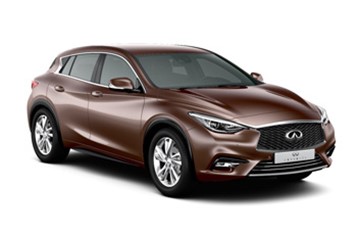
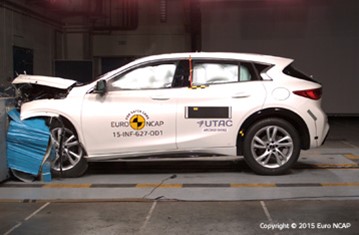
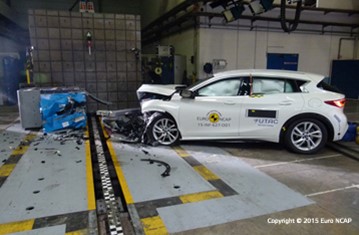
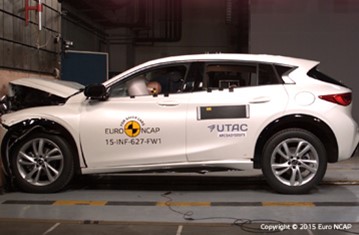
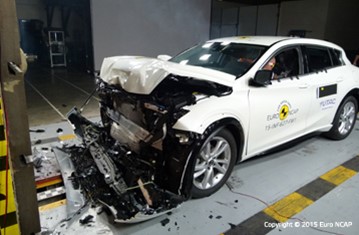
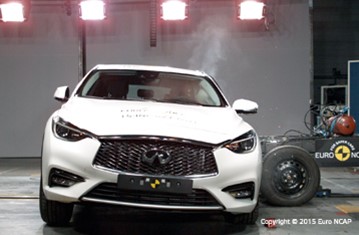

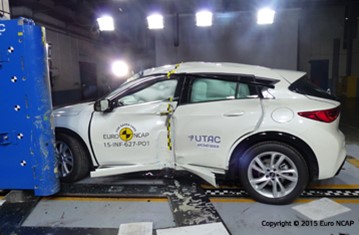
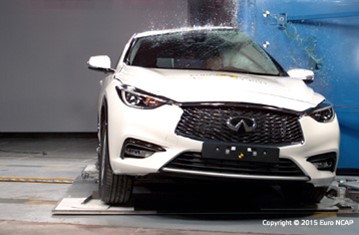



The passenger compartment remained stable in the frontal offset impact. Dummy readings indicated good protection of the knees and femurs of the driver and passenger. Infiniti showed that a similar level of protection would be provided to occupants of different sizes and to those sat in different positions. The Q30 scored maximum points for its protection of the front passenger dummy, with good protection of all critical body areas. In the full width rigid barrier test, protection of the driver was good for all body regions. For the rear passenger, protection of the head and femurs was good and that of the neck and chest was adequate. Full points were scored in the side impact barrier test, with good protection of all critical parts of the body. However, in the more severe side pole test, dummy readings of rib compression indicated marginal protection of the chest. Tests on the front seats and head restraints demonstrated a marginal level of whiplash protection in the event of a rear-end collision. A geometric assessment of the rear seats indicated poor whiplash protection for the occupants of those seats. The Q30 has a standard-fit autonomous emergency braking system which performed well in Euro NCAP's tests of its low-speed functionality. However, the system performance was not rewarded as front-seat whiplash protection was not rated as good.